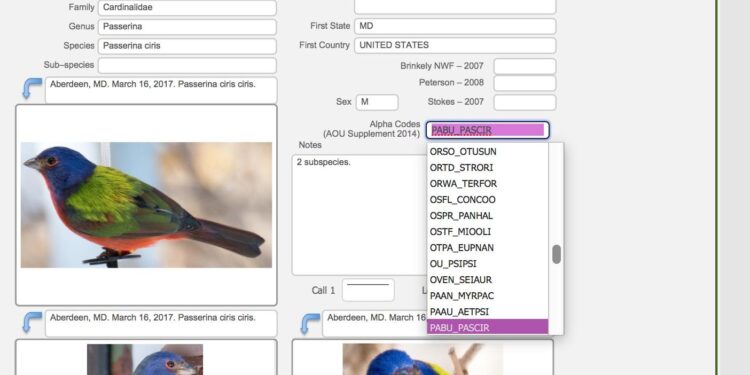A new online bird database featuring detailed information on 11,500 species has become an invaluable resource for ornithologists, birdwatchers, and nature enthusiasts alike. Launched under the Popular Science banner, this comprehensive platform offers extensive data, high-quality images, and insights into avian behavior, habitats, and conservation status. As interest in biodiversity and environmental preservation grows worldwide, this database aims to deepen public understanding and appreciation of the planet’s rich birdlife.
Comprehensive Features Reveal Bird Species Like Never Before
The database transcends traditional bird guides by integrating high-resolution images, extensive audio calls, and detailed habitat maps for every listed species. Users can filter searches based on region, behavior, or conservation status, making it an indispensable tool for both amateur birdwatchers and professional ornithologists. The platform also features an interactive identification key that uses AI-powered algorithms to suggest species based on user input such as size, color patterns, and beak shape.
Moreover, the database supports community-driven contributions, enriching its repository with real-time sightings and migratory patterns. Below is a snapshot of key attributes offered for each species:
| Feature | Description |
|---|---|
| Visual Gallery | Multiple angles, juvenile and adult stages |
| Audio Library | Calls, songs, and mimicry recordings |
| Range Maps | Seasonal and year-round distribution |
| Conservation Info | Threat levels and protective measures |
| User Feedback | Latest observations and photos |
In-Depth Data Supports Conservation and Research Efforts
By compiling detailed information on over 11,500 bird species, this extensive database acts as a vital resource for conservationists and researchers worldwide. It offers precise data on habitat preferences, migratory patterns, and population trends, enabling targeted conservation strategies that address the most pressing threats. With rapidly changing ecosystems, having access to real-time updates and historical comparisons empowers experts to predict ecological shifts and implement measures that protect vulnerable species before it’s too late.
The platform provides a plethora of analytical tools that support ongoing scientific studies, including:
- Geo-mapping visualizations to track species distribution across continents
- Behavioral data logs derived from citizen science contributions
- Population census comparisons over multiple decades
These capabilities foster collaboration between academic institutions, government agencies, and birdwatchers alike, promoting a unified front in the battle against biodiversity loss.
| Data Type | Sample Insight | Impact on Conservation |
|---|---|---|
| Habitat Range | Expansion of coastal birds in urban areas | Adjusts conservation zones to new urban threats |
| Migratory Routes | Shifted pathways due to climate change | Improved protection along key stopover sites |
| Population Trends | Decline in select raptor species since 2000 | Prioritizes funding for breeding programs |
Expert Tips for Navigating and Utilizing the Bird Database Effectively
Maximize your experience with the extensive bird database by leveraging its advanced filtering options. Start by using geographical filters to narrow down species native to specific regions or migratory patterns. This feature is especially useful for ornithologists and birdwatchers aiming to study or locate birds in their natural habitats. Additionally, explore the habitat-based search to identify species thriving in environments like wetlands, forests, or urban areas. Pair these functions with seasonal filters to track changes in bird populations throughout the year, allowing for in-depth analysis of behavioral trends.
To streamline your research, take advantage of the database’s interactive comparison tables, which allow quick side-by-side evaluations of various species. Here’s a sample of how the comparison tool can highlight key attributes:
| Species | Average Wingspan | Typical Habitat | Status |
|---|---|---|---|
| Scarlet Macaw | 90-95 cm | Tropical Rainforest | Least Concern |
| Bald Eagle | 180-230 cm | Near Water Bodies | Least Concern |
| Snowy Owl | 125-150 cm | Arctic Tundra | Vulnerable |
Make the most of multimedia assets embedded within species profiles, including high-resolution images and audio clips of bird calls, to enhance identification accuracy. Bookmark frequently referenced species and subscribe to updates for real-time notifications about new data or conservation alerts. Remember, regular engagement with the database’s community forums provides valuable insights and fosters connections with fellow bird enthusiasts worldwide.
To Conclude
As birdwatching continues to captivate enthusiasts and scientists alike, this comprehensive database featuring 11,500 species offers an unprecedented resource for exploration and study. Whether you’re a seasoned ornithologist or a curious newcomer, the platform provides detailed information and stunning visuals that bring the avian world closer than ever before. Stay tuned as this evolving repository promises to expand our understanding of bird biodiversity and inspire a deeper appreciation for these remarkable creatures.































